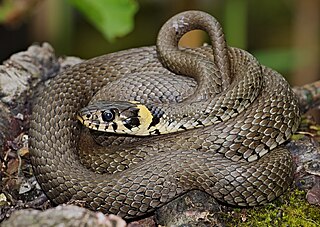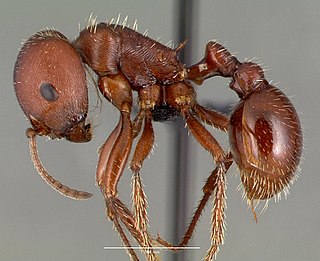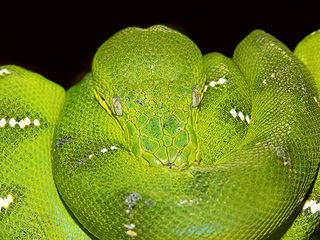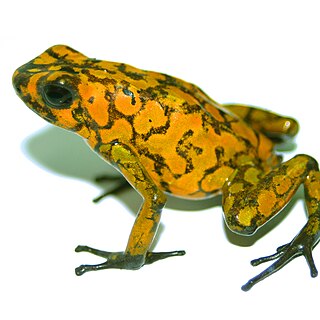Related Research Articles

The fauna of Australia consists of a huge variety of animals; some 46% of birds, 69% of mammals, 94% of amphibians, and 93% of reptiles that inhabit the continent are endemic to it. This high level of endemism can be attributed to the continent's long geographic isolation, tectonic stability, and the effects of a unique pattern of climate change on the soil and flora over geological time. A unique feature of Australia's fauna is the relative scarcity of native placental mammals. Consequently, the marsupials – a group of mammals that raise their young in a pouch, including the macropods, possums and dasyuromorphs – occupy many of the ecological niches placental animals occupy elsewhere in the world. Australia is home to two of the five known extant species of monotremes and has numerous venomous species, which include the platypus, spiders, scorpions, octopus, jellyfish, molluscs, stonefish, and stingrays. Uniquely, Australia has more venomous than non-venomous species of snakes.

Cryptoblepharus is a genus of skinks, lizards in the family Scincidae. The genus contains at least 53 species.

Belize is a country with a rich variety of wildlife, due to its unique position between North and South America, and a wide range of climates and habitats for plant and animal life. Belize's low human population, and approximately 8,867 square miles (22,970 km2) of undistributed land, provides an ideal home for more than 5000 species of plants, and vast numbers species of animals — with several hundred vertebrates including armadillos, snakes, and monkeys.

The grass snake, sometimes called the ringed snake or water snake, is a Eurasian non-venomous colubrid snake. It is often found near water and feeds almost exclusively on amphibians.

The thorny devil, also known commonly as the mountain devil, thorny lizard, thorny dragon, and moloch, is a species of lizard in the family Agamidae. The species is endemic to Australia. It is the sole species in the genus Moloch. It grows up to 21 cm (8.3 in) in total length, with females generally larger than males.

Trinidad and Tobago are continental islands with a geologically very recent history of direct land bridge connection to South America. As a result, unlike most of the Caribbean Islands, Trinidad and Tobago supports a primarily South American flora and fauna and has greater diversity of plant and animal species than the Antilles. However, rates of endemism are lower than in the rest of the Caribbean because there has been less time for genetic isolation from mainland populations because of the history of land bridge connections and hence fewer opportunities for speciation, and so a greater proportion of the species in Trinidad and Tobago are also found on the South American mainland. Trinidad is nearer to mainland South America and has been directly connected to the mainland via land bridges more often and for longer periods than Tobago. This, as well as Trinidad's larger size and more varied topography and hydrology compared to that of Tobago allow greater species and ecosystem diversity on the former compared to that on the later of the islands.

Pogonomyrmex is a genus of harvester ants, occurring primarily in the deserts of North, Central, and South America, with a single endemic species from Haiti.

The Wildlife of Costa Rica comprises all naturally occurring animals, fungi and plants that reside in this Central American country. Costa Rica supports an enormous variety of wildlife, due in large part to its geographic position between the North and South American continents, its neotropical climate, and its wide variety of habitats. Costa Rica is home to more than 500,000 species, which represents nearly 5% of the total species estimated worldwide, making Costa Rica one of the 20 countries with the highest biodiversity in the world. Of these 500,000 species, a little more than 300,000 are insects.

The emerald tree boa is a boa species found in the rainforests of South America. Since 2009 the species Corallus batesii has been distinguished from the emerald tree boa. Like all other boas, it is not venomous.

The pickerel frog is a small North American frog, characterized by the appearance of seemingly "hand-drawn" squares on its dorsal surface.

ABQ BioPark Zoo, located in Albuquerque, New Mexico, is a facility of the Albuquerque Biological Park. Founded in 1927, the 64-acre (26 ha) zoo was originally known as the Rio Grande Zoo. Sections of the zoo include an Africa exhibit area, an Australia exhibit area, the "Cat Walk" and herpetology area. An endangered species carousel was added in 2016. A narrow-gauge railroad connects the zoo to the other facilities of the Albuquerque Biological Park. Walking distance through the zoo is 2.27 miles (3.65 km).

The wildlife of Malaysia is diverse, with Malaysia being a megadiverse country. Most of the country is covered in rainforest, which hosts a huge diversity of plant and animal species. There are approximately 361 mammal species, 694 bird species, 250 reptile species, and 150 frog species found in Malaysia. Its large marine territory also holds a great diversity of life, with the country's coastal waters comprising part of the Coral Triangle.

Oophaga sylvatica, sometimes known as its Spanish name diablito, is a species of frog in the family Dendrobatidae found in Southwestern Colombia and Northwestern Ecuador. Its natural habitat is lowland and submontane rainforest; it can, however, survive in moderately degraded areas, at least in the more humid parts of its range. It is a very common frog in Colombia, but has disappeared from much of its Ecuadorian range. It is threatened by habitat loss (deforestation) and agricultural pollution and sometimes seen in the international pet trade.

Lithodytes is a genus of frogs in the family of Leptodactylidae. It is monotypic, being represented by the single species, Lithodytes lineatus, also commonly known as the gold-striped frog or painted antnest frog. It is found in tropical South America where it lives in humid forests among the leaf litter. These frogs build foam nests at the edge of temporary pools, and the tadpoles develop within these. The frogs also associate with certain leafcutter ants and breed inside their nests without being attacked by the ants.
Phrynomantis microps is an African frog with many interesting adaptations to the savannah. These frogs are also called the Accra snake-necked frog. They are found across Western and Central Africa. One of its distinguishing features is the peptide secretion on its skin, which goes beyond toxicity and seems to inhibit aggressive behavior like biting and stinging from large ants. This allows Phrynomantis microps to live in humid burrows within large ant nests and termite mounds, where they are frequently found. While Phrynomantis microps feeds on similar insects such as the termite Macrotermes bellicosus, they have never been found to feed on the ants they share the nest with. These frogs are medium sized and have a bright red pelvic region.

Lenomyrmex is a Neotropical genus of ant in the subfamily Myrmicinae.

The fauna of Louisiana is characterized by the region's low swamplands, bayous, creeks, woodlands, coastal marshlands and beaches, and barrier islands covering an estimated 20,000 square miles, corresponding to 40 percent of Louisiana's total land area. Southern Louisiana contains up to fifty percent of the wetlands found in the Continental United States, and are made up of countless bayous and creeks.

Florida hosts many types of fauna. From coral reefs of the Florida Keys to the cypress swamps of the Panhandle, the state's diverse habitats are home to a variety of wildlife. Florida is among the top five states in terms of endemic species. There are over 700 terrestrial animals, 200 freshwater fish species, 1,000 marine fish and thousands of terrestrial insects and other invertebrates that inhabit the state. Florida's peninsular geography spans from subtropical to tropical zones, which, combined with its distinctive geology and climate, contribute to habitat diversity and an array of species. The native wildlife that exists in the state are of temperate and tropical origin.
References
- ↑ Bolton, B. (2016). "Lenomyrmex hoelldobleri". AntCat. Retrieved 19 October 2016.
- 1 2 Bittel, Jason. "Devil Frog Vomits Up a New Ant Species".